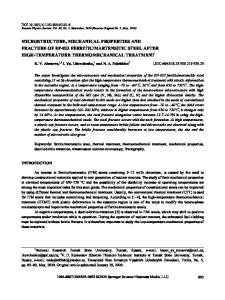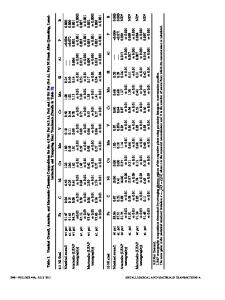Mechanical Performance of Ferritic Martensitic Steels for High Dose Applications in Advanced Nuclear Reactors
- PDF / 1,171,680 Bytes
- 14 Pages / 593.972 x 792 pts Page_size
- 81 Downloads / 367 Views
sitions creating Frenkel pairs: a vacancy and a self-interstitial atom (SIA). The primary knock-on atom and the recoiling energetic particle cause additional collisions with other atoms, generating a cascade of displaced atoms. The damage dose in irradiated material is typically quantified in terms of displacements per atom (dpa). One dpa corresponds to every atom being displaced from its lattice position on average one time. Some of the components in advanced reactors may experience extreme radiation doses of>100 dpa in components such as the fuel clad and ducts of a sodium-cooled fast reactor.[19] At operating temperatures of the reactors, vacancy and interstitial diffusion are thermally active in general. As a result, many of these defects produced in cascades are annihilated via recombination and have no effect on the mechanical properties. However, a small fraction of the initial defects remain and agglomerate or migrate to sinks such as grain or lath boundaries, interfaces between precipitates and matrix, and dislocations. These sinks are also recombination sites for point defects. However, vacancies and SIAs have a bias for certain sinks and different mobility at a given temperature. For instance, SIAs are more mobile than vacancies and have bias for dislocations due to long-range strain interactions.[1] Point defects’ preferential migration to different sinks creates an unbalanced number resulting in clustering. The temperature-sensitive clustering of these remaining point defects leads to degradation in properties from radiation damage. At lower temperatures ~0.3TM < (where TM is the melting temperature), clustering of radiation-induced defects inhibits dislocation motion resulting in hardening and reduction in ductility and fracture toughness. At these temperatures, SIAs are more mobile than vacancies and form loops. Irradiationinduced hardening is observed at low doses (~0.1 dpa) and can limit low temperature operations.[2] Hardening increases with dose and tends to saturate at ~10 dpa. At intermediate temperatures 0.3 to 0.6 TM, vacancies VOLUME 44A, JANUARY 2013—S71
Table I. Alloy T91 HT-9M HT-9 F82H MANET NF616 HCM12A EM10 (9Cr1Mo) EUROFER RAFM-9Cr2WTaV
Nominal Compositions of Some of the High Chromium F/M Steels in Weight Percentage C
N
Cr
Mo
Mn
Ni
Si
V
Nb
W
Ta
0.08 0.15 0.21 0.10 0.14 0.07 0.11 0.096 0.11
0.054 0.018 —
Data Loading...











